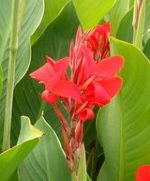
Canna is a genus of herbaceous perennials in the Cannaceae family that is most closely related to plants such as banana, ginger, and bird of paradise. It is native to tropical and subtropical America and Asia and includes about 20 species, a few of which are garden worthy. Plants grow from a rhizomatous rootstock and have a stout unbranched fleshy stem clasped by the bases of large paddle-like leaves that are usually green but may be bronze, maroon or variegated. The flower parts in threes with each flower having three inconspicuous long green petals and three small green sepals but large, prominent, colorful, modified stamens called stamenods. The inner most stamenod forms a lip, that is sometimes reflexed. Flowers may be red, orange, yellow or a combination, and appear in terminal spikes from mid summer to frost. The genus name, Canna, comes from the Greek word, kanna, meaning red.Most cannas like full sun and fertile, well-manured, consistently moist, well-drained soil. Although tropical, they can be grown in cold climates by cutting them back to 6″ after the first frost and stored in a cool dry place during the winter. Propagation is by division at planting time, and seed after soaking for 24 hours and scarification. Cannas lend a tropical look to a garden and are a good choice for borders or containers.
Most of the cannas growing in gardens today are the hybrids described as C. x generalis below but there are other garden worthy species as follows.
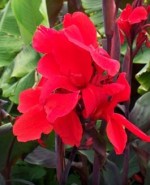 Garden Hybrid Cannas (C. x generalis aka C. x hortensis)
Garden Hybrid Cannas (C. x generalis aka C. x hortensis)
Cultivars vary dramatically in height and color of flowers and leaves.
Height: 1.5-9′
Flower Color:Red, pink, yellow, cream, orange
Leaf Color: Green, bronze, maroon, variegated
Hardiness: Zones 7-10
C. glauca
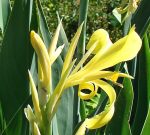 The slender flowers have obovate staminodes 3′ long, and narrow notched lip.
The slender flowers have obovate staminodes 3′ long, and narrow notched lip.
Height: 4-6′
Flower Color:Pale yellow
Leaf Color:Bluish green rimmed with white
Hardiness: Zones 8-10
Indian Shot (C. indica)
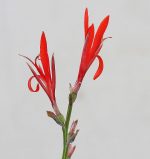 The black round or egg shaped seeds resemble shot gun pellets giving the plant its common name. The roots of the plant have been a source of food in the Americas for thousands of years. The cultivar ‘Purpurea’ has purplish leaves.
The black round or egg shaped seeds resemble shot gun pellets giving the plant its common name. The roots of the plant have been a source of food in the Americas for thousands of years. The cultivar ‘Purpurea’ has purplish leaves.
Height: 3-6′
Flower Color: Bright red with orange lip and throat sometime speckled with red
Leaf Color: Bronze or green
Hardiness: Zones 8-10
C. iridiflora
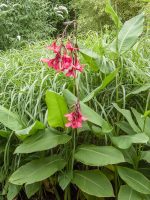
The 2′ long leaves are sometimes wooly underneath when young. Flowers are 1.5″ long and hand in showy slightly branched racemes subtended by grayish bracts. Stamenodes grow up to 5′ long and the lip apex is cleft.
Height: 4-10
Flower Color:Pink
Leaf Color:Bluish green
Hardiness: Zones 8-10
Photo Credit: Peter Coxhead, Wikipedia
C. warscewiczii
 Purplish stems bear oblong 1.5′ long leaves with heart shaped base. Stamonodes are oblanceolate and lip is reflexed and notched. Showy seed capsule is 1.2-1″ across, prickly, and light crimson.
Purplish stems bear oblong 1.5′ long leaves with heart shaped base. Stamonodes are oblanceolate and lip is reflexed and notched. Showy seed capsule is 1.2-1″ across, prickly, and light crimson.
Height: 5-6
Flower Color:Crimson
Leaf Color: Green with purple rim
Hardiness: Zones 9-10